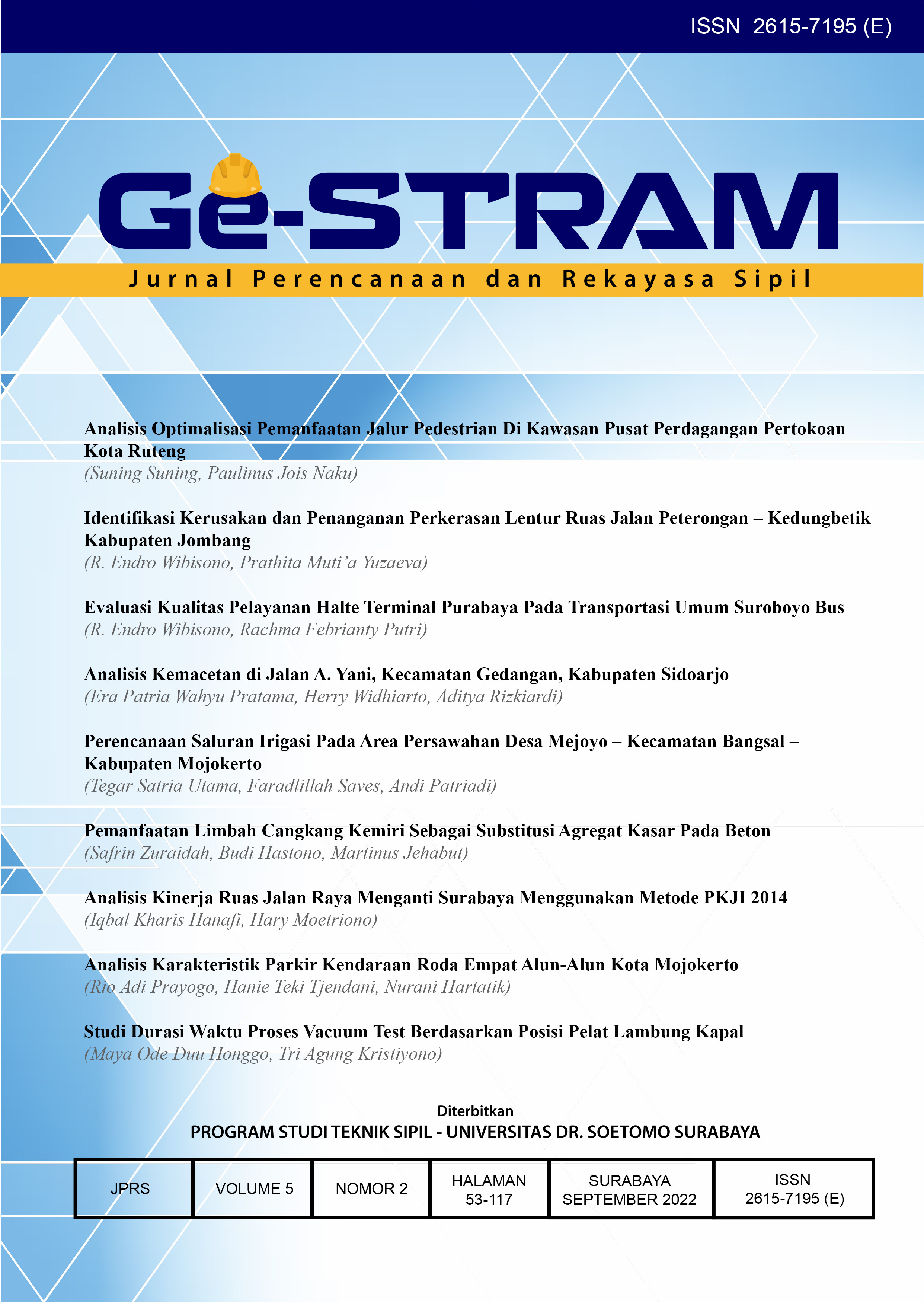Analisis Kinerja Ruas Jalan Raya Menganti Surabaya Menggunakan Metode PKJI 2014
 Abstract views: 1205
,
Abstract views: 1205
,
 PDF downloads: 3044
PDF downloads: 3044
Abstract
Menganti roadway Surabaya is one of the roads in the city of Surabaya with the type of road 4/2T. This street is a densely populated residential area as well as a shopping, business and commercial area. The road section has many shops and stalls, and community activities such as commuting to the office, school activities that make the roads become congested so that vehicles are prone to buildup. In addition, the influence of side barriers such as the stopping of motorized vehicles on the shoulder of the road, pedestrians crossing not at the zebra cross, loading and unloading of goods on the shoulder of the road and vehicles parked on the shoulder of the road which can interfere with passing vehicles and cause vehicle density on the road. The method in this study uses the 2014 Indonesian Road Capacity Guidelines (PKJI 2014) by collecting data by observing traffic so that the total traffic volume, road capacity, degree of saturation and traffic forecasting in the next few years can be calculated. From the results of the analysis, the peak hour traffic volume occurs in direction A on Wednesday, March 16, 2022 at 16.00 - 17.00 WIB with a total of 2208.5 cur/hour and has a road capacity of 2919,312 cur/hour with these results obtained the value of the degree of saturation is 0.76.
References
Abdul Rozzaq (2019), “Analisis Kapasitas Ruas Jalan Girilaya Surabaya” Fakultas Teknik Universitas 17 Agustus 1945 Surabaya
Anggi Sartika Wiguna, Wijono, M.Aziz Muslim (2014), Jurnal “Analisis dan Peramalan Kepadatan Jalan Raya Kodya Malang dengan FTS Average Based”
Badan Pusat Statistik Kota Surabaya, 2020. Sensus Penduduk Kota Surabaya. Badan Pusat Statistik (BPS) Kota Surabaya.
Charles Tri Ardianata (2017), “Analisis Kinerja Ruas Jalan Blauran-Bubutan Akibat Pengoprasian Trem Kota Surabaya – Provinsi Jawa Timur” Fakultas Teknik Institut Teknologi Sepuluh Nopember Surabaya. Departemen Permukiman dan Prasarana Wilayah. Survai Pencacahan Lalu Lintas dengan cara manual
Fidel Miro (2012), Pengantar Sistem Transportasi : Fakultas Teknik Sipil dan Perencanaan Universitas Bung Hatta, Padang.
Izzuddin Ahmad (2020), “Analisis Kinerja Ruas Jalan Sumatra di Kabupaten Gresik” Fakultas Teknik Universitas 17 Agustus 1945 Surabaya.
Kementrian Pekerjaan Umum. Kapasitas Jalan Perkotaan diambil dari Pedoman Kapasitas Jalan Indonesia 2014 (PKJI 2014)
Kementrian Pekerjaan Umum. Kapasitas Jalan Perkotaan diambil dari Manual Kapasitas Jaalan Indonesia (MKJI 1997)
MDP – 2017 (2017). Manual Desain Perkerasan Jalan Nomor 02/M/BM/2017, Kementrian Pekerjaan Umum dan Perumahan Rakyat Direktorat Jendral Bina Marga
Nuruzzakiyah (2015), “Pengaruh Hambatan Samping Terhadap Kinerja Ruas Jalan Lambung Mangkurat di Pasar Rahmat Kota Samarinda”.
Randy Syaputra, Syukur Sebayang, dan Dwi Herianto (2015), “Pengaruh Hambatan Samping Terhadap Kinerja Lalu Lintas Jalan Nasional”.
Ratna Dwi Nurmaya (2020), “Analisis Kinerja Jalan Majyen Sungkono Surabaya” Fakultas Teknik Universitas 17 Agustus 1945 Surabaya.
Rusdianto Horman Lalenoh Theo K.Sendow, Freddy Jansen (2015), “Analisis Kapasitas Ruas Jalan Sam Ratulangi Dengan Metode MKJI 1997 dan PKJI 2014”.
Copyright (c) 2022 Iqbal Kharis Hanafi, Hary Moetriono

This work is licensed under a Creative Commons Attribution-ShareAlike 4.0 International License.
Authors who publish with this journal agree to the following terms:
- Authors retain copyright and grant the journal right of first publication with the work simultaneously licensed under a Creative Commons Attribution-ShareAlike 4.0 International License that allows others to share the work with an acknowledgement of the work's authorship and initial publication in this journal.
- Authors are able to enter into separate, additional contractual arrangements for the non-exclusive distribution of the journal's published version of the work (e.g., post it to an institutional repository or publish it in a book), with an acknowledgement of its initial publication in this journal.
- Authors are permitted and encouraged to post their work online (e.g., in institutional repositories or on their website) prior to and during the submission process, as it can lead to productive exchanges, as well as earlier and greater citation of published work (See The Effect of Open Access).

This work is licensed under a Creative Commons Attribution-ShareAlike 4.0 International License.















